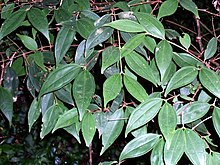
Cyrilla racemiflora, the sole species in the genus Cyrilla, is a flowering plant in the family Cyrillaceae, native to warm temperate to tropical regions of the Americas, from the southeastern United States, south through the Caribbean, Mexico and Central America to northern Brazil and Venezuela in South America. Common names include swamp cyrilla, swamp titi, palo colorado, red titi, black titi, white titi, leatherwood, ironwood, he huckleberry, and myrtle.
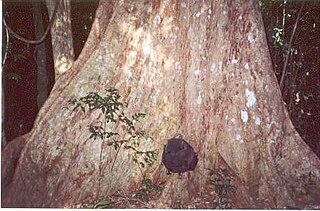
Syzygium francisii is a native Australian tree, common on the eastern sea board, between Morisset, New South Wales and Gladstone, Queensland. Common names include giant water gum, rose satinash, and Francis water gum. The habitat of Syzygium francisii is rainforest on basaltic or fertile alluvial soils.

Paratrophis pendulina is a species of flowering plant in the mulberry family, Moraceae. In Australia it is commonly known as whalebone tree, and other common names include the white handlewood, axe-handle wood, grey handlewood and prickly fig. In Hawaii it is known as Hawai'i roughbush or aʻiaʻi in Hawaiian.
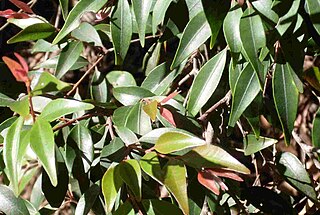
Uromyrtus australis, commonly known as the peach myrtle, is a small tree growing around Nightcap National Park, New South Wales, Australia. It is endangered by extinction. The delicate foliage, pink flowers and appealing fruit makes this a particularly beautiful tree.

Cryptocarya glaucescens, commonly known as jackwood, is a rainforest tree of the laurel family growing in eastern Australia.

Symplocos stawellii, or the white hazelwood, is a rainforest tree growing in eastern Australia. It often grows along creeks in gullies, in tropical and sub-tropical rainforests. The natural distribution is from Gerringong Creek in the upper Kangaroo Valley of New South Wales to the Atherton Tableland in tropical Queensland. It also occurs in New Guinea.
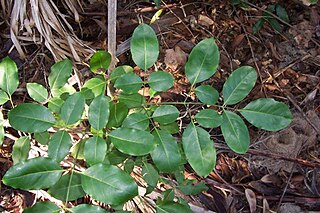
Polyscias elegans, known as the celery wood, is a rainforest tree of eastern Australia. It occurs in a variety of different rainforest types, from fertile basaltic soils, to sand dunes and less fertile sedimentary soils. The range of natural distribution is from Jervis Bay in southern New South Wales to Thursday Island, north of the Australian continent. Other common names include black pencil cedar and silver basswood. Polyscias elegans is useful to bush regenerators as a nursery tree, which provides shade for longer-lived young trees underneath. Polyscias elegans is also known as Celery wood, Mowbulan whitewood, Silver basswood and White sycamore.

Syzygium hodgkinsoniae is a rare subtropical rainforest tree, growing on alluvial soils by streams in the north east New South Wales and south east Queensland, Australia. The range of natural distribution is from the Richmond River, New South Wales to Gympie in south east Queensland. Common names include smooth-bark rose apple or red lilly pilly.

Cryptocarya laevigata, known as the glossy laurel or red-fruited laurel, is a rainforest plant, which ranges from Malesia and New Guinea to eastern Australia. In Australia it grows in the rainforest understorey on fertile soils, from the Richmond River, New South Wales to Cairns in tropical Queensland, where it is often seen in association with the White Booyong.

Backhousia leptopetala is a common Australian tree, growing from Stanwell Park in the northern Illawarra district to near Buderim in south eastern Queensland.

Backhousia subargentea is a rare Australian rainforest tree, growing near Mullumbimby in north eastern New South Wales and from Boonah to Imbil in south eastern Queensland.

Cryptocarya bidwillii, the yellow laurel, is a small to medium-sized tree in the laurel family. Occurring in Australian rainforests from Nymboida in the state of New South Wales to Townsville in tropical Queensland. Often found in the dryer ridges in dry rainforest or in viney scrubs.

Drypetes deplanchei is a tree of eastern and northern Australia. It also occurs in New Caledonia and Lord Howe Island. The genus is derived from the Greek, dryppa meaning "olive fruit". The species named after Dr. Emile Deplanche, who collected this plant at New Caledonia. Common names include yellow tulip, grey boxwood, white myrtle, grey bark and yellow tulipwood.
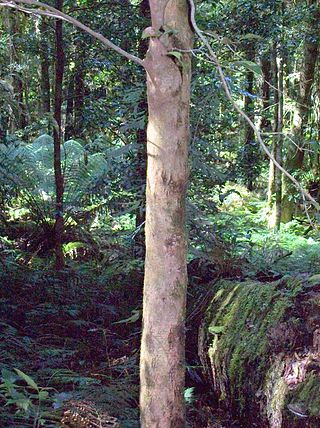
Gossia acmenoides, known as the scrub ironwood, is a rainforest tree of the family Myrtaceae, native to eastern Australia. The usual habitat of this small tree is drier rainforest areas. The range of natural distribution is from Jamberoo in New South Wales to Eungella National Park in northern Queensland.

Cinnamomum virens is a rainforest tree growing in the eastern coastal parts of Australia. Common names include red-barked sassafras, black sassafras, camphorwood, scentless cinnamon wood, and native camphor laurel. Its habitat is between the Williams River and the Main Range National Park in Queensland. Growing in rich volcanic soils or on the poorer sedimentary soils, it is often in association with coachwood.

Rhodamnia argentea is a rainforest tree of eastern Australia. Commonly known asmalletwood, white myrtle, silver leaf, silver malletwood and white turpentine. The natural habitat is a variety of different rain forests, at sea level or in the adjacent ranges. Growing on sand, alluvium and volcanic based soils. From the Hastings River, New South Wales to Bowen, Queensland.

Rhodamnia is a group of rainforest trees and shrubs in the myrtle family described as a genus in 1822. They are native to southern China, Southeast Asia, Papuasia, Australia, and New Caledonia.

Decaspermum humile, commonly known as the silky myrtle, is a tree from Australia and Asia. It can be used as bush food, as indicated by the alternate common name of currant myrtle. The tree features an attractive dark glossy crown. The new pink leaves with silvery hairs are particularly appealing.

Rhodamnia maideniana, known as the smooth scrub turpentine, is a rare sub-tropical rainforest plant of eastern Australia. It is listed on ROTAP with a rarity factor of 2RC-.

Uromyrtus lamingtonensis is a rare Australian shrub growing around the state border of New South Wales and Queensland. Like the Peach Myrtle, it has attractive pink flowers.
